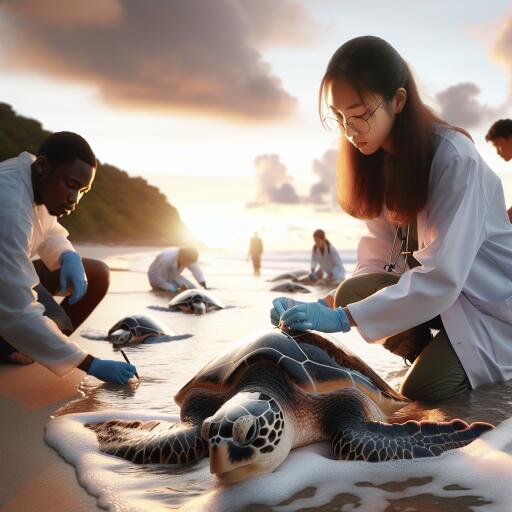
Internal Tagging Confirms Long-Term Survivability of Rehabilitated Sea Turtles
For years, the dedicated team of veterinarians and scientists at the New England Aquarium has been tirelessly working to rehabilitate sea turtles stranded along the coast. These endangered creatures face numerous health issues such as hypothermia and pneumonia, as well as injuries from turbulent ocean conditions. While thousands have been successfully treated and released back into the ocean, their survival after vanishing beneath the waves was a considerable mystery. Until now.
Recent advancements in technology have given researchers the tools they need to monitor these turtles for extensive periods post-release. This breakthrough involves the application of technology that had never before been used with sea turtles, allowing for an unprecedented look into their lives once returned to their natural habitat.
In 2021, the aquarium was granted federal permits to surgically implant acoustic transmitters in loggerheads. These transmitters offer a battery life of three to ten years based on the turtle’s size, enabling researchers to gather data on survival and migratory behavior, which was virtually impossible with older, less durable external tags.
“These tags emit ultrasonic signals uniquely coded to each transmitter. It’s much like an E-ZPass system, with each tag having its unique identification code,” explained Dr. Kara Dodge, a research scientist involved in spearheading this project.
Fourteen rehabilitated loggerheads received these acoustic tags and were released between 2021 and 2022. With four years of data now available, not only are the turtles surviving, but they are also returning to the same areas of southern New England, notably the Nantucket Sound off Cape Cod.
These findings offer significant insight into the migration patterns of loggerheads. They affirm the long-term survivability of rehabilitated sea turtles, establish the feasibility of internal acoustic tagging for various species, and provide valuable data that can influence future conservation efforts.
“Understanding that the turtles are surviving beyond the first year after release is enormous. Previously, we lacked information on their long-term outcomes beyond a single year,” said Dodge.
The processes for acquiring permits for tagging sea turtles differ depending on the species’ conservation status. More endangered species face stricter requirements.
“This research started as a pilot study, focusing specifically on loggerheads since they are considered threatened rather than critically endangered. Encouraged by these promising results, we are seeking permits to extend our study to include Kemp’s Ridley and green sea turtles,” Dodge added.
Moreover, the data highlights the increasing ecological significance of New England’s coastal waters for sea turtles. These marine creatures have been venturing further north and remaining longer, likely influenced by various factors, including ocean temperature changes.
“New England is the northern boundary of their range. They come here primarily to indulge in the plentiful shellfish and crabs,” noted Dodge.
Between November and January, over 800 turtles were stranded along the Massachusetts coast. Just 15 years ago, about 100 winter strandings were typical, but the figure has increased more than fivefold since then.
The use of advanced tools for such environmental studies marks a significant stride in ecological research and conservation efforts, emphasizing the critical role of technology in understanding and protecting our natural world.





Leave a Reply